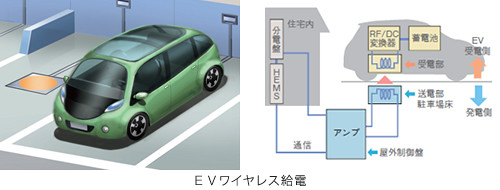This Japan column reports on promising developments in energy density of EV batteries from Toyota, wireless charging experiments, which are part of a Smart City Project, and the growing charging infrastructure in the Kanto area. Also, the end of the Eco Car subsidy program was marked by a total government assistance of €2.7bil.
 Toyota develops a new all-solid battery type with 5 times higher power density
Toyota develops a new all-solid battery type with 5 times higher power densityLast week at an event in Tokyo, Toyota presented its latest achievements in energy storage technology. In the prototype battery the lithium-ion battery electrolyte was replaced by all solid electrolyte improving overall compactness. According to Toyota this world leading technology considerably improves the transfer of ions. The results show 5x increased power output per unit of volume. The new all-solid battery is in the development stage, in order to make practical use of the technology an inexpensive substitute to Germanium will be necessary.

Source: Toyota
Experimental installation of cutting edge wireless charging technology
As a part of the Smart City Project in Kashiwa, Chiba prefecture, an experimental test of a smart house equipped with the latest environmental and energy conscious technology will begin in November 2012. Among the technologies that deserve the most attention is the EV wireless charging system installed in the parking space of the house. The wireless charging system works on the principle of magnetic field resonance.

Source: Mitsui Home
Over 50 charging spots in Kanto area – newly launched service of the Japan Charge Network
A new charging network with a membership system will be launched in October. Japan Charge Network is working on this project with several major infrastructure operators, retail store and restaurants chains. Over 50 charging spots will be available at highways, convenience stores, airport, family restaurants and other often visited locations. The members of the network will be offered several price plans from “single charge” to “super value plan”. Similar initiatives are contributing to the rapidly increasing number of charging stations throughout Japan – building up essential infrastructure making the wider spread of EVs possible. Similar to the “Coco Juden” project mapping charging stations in Japan, Nissan Motor company is a 30% share holder of the Japan Charge Network.

Source: Japan Charge Network
Electric vehicle technology development exhibition - EVEX 2012
Tokyo Big Sight was the place to be last week for all the fans of latest EV industry research and development. Over three days, the EVEX 2012 exhibition informed visitors on various infrastructure and vehicle solutions. Particular focus seemed to be on the charging stations. Technology examples ranging from small portable or coin chargers to large fast charging stations can be found in the photos gallery of the original article (here) in Japanese.
End of the Eco Car subsidy program
September 21st was the last day to apply for a subsidy from the Japanese Ministry of Economy, Trade and Industry for the purchase of a personal eco car. Considered under the eco car category are electric vehicles (EV), hybrid electric vehicles (HEV), plug-in HEV, but also low emission vehicles with an internal combustion engine. The subsidy program started on the 2nd April, and on the very last day received 34,000 applications, totalling €32.7mil. The total amount granted in subsidies for the duration of the program was €2.7bil.
The original articles are listed below in the order of appearance in the column.






